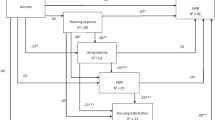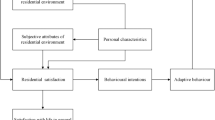Abstract
In 20 years, housing reform in China has transformed its urban housing system from housing welfare into a housing market, which has led to a unique housing stratification. Traditionally, housing status is considered an important indicator of social stratification while studies of residents’ social satisfaction also consider housing status and stratification as important factors. Using national data from the Chinese Academy of Social Sciences–National Institute of Social Development, this paper investigates the status of urban household housing and its impact on individuals’ social satisfaction. Latent Class Analysis method was used to identify four housing strata from multiple dimensions and analyze the social satisfaction among these strata. The results show that variables such as the type of residential community, housing status, housing assets, and household income have significant impact on urban households’ social satisfaction. In particular, family income and number of housing units show a clear U-shaped characteristic curve. Latent Class Analysis shows that the housing strata of urban households can be divided into top, middle, sandwiched, and poor classes. Analyses of variance show that different housing strata have different attitudes about those social dimensions, and the sandwiched housing class’s social satisfaction is relatively low compared with other housing strata.


Similar content being viewed by others
References
Alejandro, O.-R., & de Almeida, H. (2017). Work engagement, social support, and job satisfaction in Portuguese nursing staff: A winning combination. Applied Nursing Research, 36, 37–41.
Amato, P. R., & Previti, D. (2003). People’s reasons for divorcing: Gender, social class, the life course, and adjustment. Journal of Family Issues, 24(5), 602–626.
Amérigo, M., & Aragonés, J. I. (1990). Residential satisfaction in council housing. Journal of Environmental Psychology, 10(4), 313–325.
Auspurg, K., Hinz, T., & Schmid, L. (2017). Contexts and conditions of ethnic discrimination: evidence from a field experiment in a German Housing Market. Journal of Housing Economics, 35, 26–36.
Bian, Y., & Li, L. (2012). The Chinese general social survey (2003-8) sample designs and data evaluation. Chinese Sociological Review, 45(1), 70–97.
Bian, Y., & Lu, C. (2014). Urban-rural housing inequality in transitional China. In Analysing China’s population (pp. 179–201). Dordrecht: Springer.
Bromley, J., Hare, D. J., Davison, K., & Emerson, E. (2004). Mothers supporting children with autistic spectrum disorders: Social support, mental health status and satisfaction with services. Autism, 8(4), 409–423.
Buckley, W. (1958). Social stratification and the functional theory of social differentiation. American Sociological Review, 23(4), 369–375.
Buss, D. M., Shackelford, T. K., Kirkpatrick, L. A., & Larsen, R. J. (2001). A half century of mate preferences: The cultural evolution of values. Journal of Marriage and Family, 63(2), 491–503.
Cao, X. J., & Wang, D. (2016). Environmental correlates of residential satisfaction: An exploration of mismatched neighborhood characteristics in the Twin Cities. Landscape and Urban Planning, 150, 26–35.
Chen, L. T., Chen, C. W., & Chen, C. Y. (2010). Are educational background and gender moderator variables for leadership, satisfaction and organizational commitment? African Journal of Business Management, 4(2), 248.
Conley, D. (2001). A room with a view or a room of one’s own? Housing and social stratification. In Sociological forum (Vol. 16, No. 2, pp. 263–280). Kluwer Academic Publishers-Plenum Publishers.
Dahrendorf, R. (2017). On the origin of inequality among men. In Social policy and public policy (pp. 41–51). Routledge.
Diener, E., & Suh, E. (1997). Measuring quality of life: Economic, social, and subjective indicators. Social Indicators Research, 40(1–2), 189–216.
Friedrichs, J. R., Galster, G., & Musterd, S. (2003). Neighbourhood effects on social opportunities: The European and American research and policy context. Housing Studies, 18(6), 797–806.
Fussell, P. (1983). Class: Style and status in the USA. Arrow.
Goldthorpe, J. H. (2017). Social inequality and social integration. In Social policy and public policy (pp. 32–40). Routledge.
Grabher, G., & König, J. (2017). Performing network theory? Reflexive relationship management on social network sites. In B. Hollstein, W. Matiaske, & K.-U. Schnapp (Eds.), Networked governance (pp. 121–140). Cham: Springer.
Hays, R. A. (2015). Neighborhood networks, social capital, and political participation: The relationships revisited. Journal of Urban Affairs, 37(2), 122–143.
Johnstone, M., Parsell, C., Jetten, J., Dingle, G., & Walter, Z. (2016). Breaking the cycle of homelessness: Housing stability and social support as predictors of long-term well-being. Housing Studies, 31(4), 410–426.
Kazak, A. E., Barakat, L. P., Meeske, K., Christakis, D., Meadows, A. T., Casey, R., et al. (1997). Posttraumatic stress, family functioning, and social support in survivors of childhood leukemia and their mothers and fathers. Journal of Consulting and Clinical Psychology, 65(1), 120.
Kerckhoff, A. C. (2001). Education and social stratification processes in comparative perspective. Sociology of Education, 74, 3–18.
King, A. T., & Mieszkowski, P. (1973). Racial discrimination, segregation, and the price of housing. Journal of Political Economy, 81(3), 590–606.
Lake, R. W. (2017). The new suburbanites: Race and housing in the suburbs. Abingdon: Routledge.
Lanza, S. T., Collins, L. M., Lemmon, D. R., & Schafer, J. L. (2007). PROC LCA: A SAS procedure for latent class analysis. Structural Equation Modeling: A Multidisciplinary Journal, 14(4), 671–694.
Liu, Y., He, S., & Wu, F. (2012). Housing differentiation under market transition in Nanjing, China. The Professional Geographer, 64(4), 554–571.
Loutskina, E., & Strahan, P. E. (2015). Financial integration, housing, and economic volatility. Journal of Financial Economics, 115(1), 25–41.
Marshall, G., & Swift, A. (1993). Social class and social justice. British Journal of Sociology, 44, 187–211.
McCamish-Svensson, C., Samuelsson, G., Hagberg, B., Svensson, T., & Dehlin, O. (1999). Social relationships and health as predictors of life satisfaction in advanced old age: results from a Swedish longitudinal study. The International Journal of Aging and Human Development, 48(4), 301–324.
Muhammad, A., Kuchinke, K. P., & Iqbal, A. (2017). The relationship between corporate social responsibility, job satisfaction, and organizational of commitment: Case NI higher education. Journal of Cleaner Production, 142, 2353–2363.
Nikitas, A., Avineri, E., & Parkhurst, G. (2018). Understanding the public acceptability of road pricing and the roles of older age, social norms, pro-social values and trust for urban policy-making: The case of bristol. Cities, 79(Sep.), 78–91.
Northridge, J., Ramirez, O. F., Stingone, J. A., & Claudio, L. (2010). The role of housing type and housing quality in urban children with asthma. Journal of Urban Health, 87(2), 211–224.
Ogbu, J. U. (1994). Racial stratification and education in the United States: Why inequality persists. Teachers College Record, 96, 264–298.
Posselt, J. R., & Grodsky, E. (2017). Graduate Education and Social Stratification. Annual Review of Sociology, 43, 353–378.
Rex, J., & Moore, R. (1967). Race, community and conflict. Oxford: Oxford University Press.
Ridgeway, C. L. (2014). Why status matters for inequality. American Sociological Review, 79(1), 1–16.
Rook, K. S. (1984). The negative side of social interaction: Impact on psychological well-being. Journal of Personality and Social Psychology, 46(5), 1097.
Rook, K. S. (1987). Reciprocity of social exchange and social satisfaction among older women. Journal of Personality and Social Psychology, 52(1), 145.
Saunders, P. (1984). Beyond housing classes: the sociological significance of private property rights in means of consumption. International Journal of Urban and Regional Research, 8(2), 202–227.
Smith, T. B., Oliver, M. N., & Innocenti, M. S. (2001). Parenting stress in families of children with disabilities. American Journal of Orthopsychiatry, 71(2), 257.
Tampubolon, G. (2010). Social stratification and cultures hierarchy among the omnivores: Evidence from the Arts Council England surveys. The Sociological Review, 58(1), 1–25.
Teck-Hong, T. (2012). Housing satisfaction in medium-and high-cost housing: The case of Greater Kuala Lumpur, Malaysia. Habitat International, 36(1), 108–116.
Tesfai, R. (2016). The interaction between race and nativity on the housing market: Homeownership and house value of black immigrants in the United States. International Migration Review, 50(4), 1005–1045.
Torssander, J., & Erikson, R. (2009). Stratification and mortality—A comparison of education, class, status, and income. European Sociological Review, 26(4), 465–474.
Tyler, T. R., & Blader, S. L. (2003). The group engagement model: Procedural justice, social identity, and cooperative behavior. Personality and Social Psychology Review, 7(4), 349–361.
Vaux, A. (1985). Variations in social support associated with gender, ethnicity, and age. Journal of Social issues, 41(1), 89–110.
Vera-Toscano, E., & Ateca-Amestoy, V. (2008). The relevance of social interactions on housing satisfaction. Social Indicators Research, 86(2), 257–274.
Walder, A. G. (1992). Property rights and stratification in socialist redistributive economies. American Sociological Review, 57, 524–539.
Yang, F. (2009). Consumption over the life cycle: How different is housing? Review of Economic Dynamics, 12(3), 423–443.
Yanos, P. T., Felton, B. J., Tsemberis, S., & Frye, V. A. (2007). Exploring the role of housing type, neighborhood characteristics, and lifestyle factors in the community integration of formerly homeless persons diagnosed with mental illness. Journal of Mental Health, 16(6), 703–717.
Yusuf, S., & Saich, A. (Eds.). (2008). China urbanizes: Consequences, strategies, and policies. Washington: World Bank Publications.
Zabriskie, R. B., & McCormick, B. P. (2003). Parent and child perspectives of family leisure involvement and satisfaction with family life. Journal of Leisure Research, 35(2), 163–189.
Acknowledgements
This paper is sponsored by the National Natural Science Foundation of China (Nos. 71473283, 71373295) and the National Social Sciences Founding Project of China (No. 16BSH124).
Author information
Authors and Affiliations
Corresponding author
Additional information
Publisher's Note
Springer Nature remains neutral with regard to jurisdictional claims in published maps and institutional affiliations.
Rights and permissions
About this article
Cite this article
Wu, Y., Chen, J., Bian, Z. et al. Housing, Housing Stratification, and Chinese Urban Residents’ Social Satisfaction: Evidence from a National Household Survey. Soc Indic Res 152, 653–671 (2020). https://doi.org/10.1007/s11205-020-02453-1
Accepted:
Published:
Issue Date:
DOI: https://doi.org/10.1007/s11205-020-02453-1




